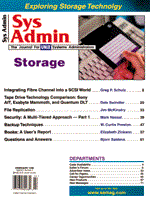
Editor's Forum
If you have been feeling a bit run-down lately, take heart. Your vitamins probably have not lost their potency, nor is it a matter of the clock catching up to you. Your condition simply may be a reaction to the cacophony of technology concerns that have been vying for your attention, perhaps even invading your dreams. The Internet, the Web, intranets, extranets, data warehouses, the Java Wars, and the sinister common thread of security are just a few of the issues that you have been dealing with over the last few months. Will somebody's Web browser become the new universal user interface? Should you rewrite all of your administrative tools in Java? If so, should your Java be pure or Windows-enhanced? Is client/server dead, or just adopting a new press-driven moniker? Small wonder that you might be tired. Where will it all end? Interestingly, the termination points of all these gotta-have technologies are spread across the storage devices that you manage. While battles rage in almost every area of technology, the clear winner in almost every case is storage. Most of these technologies demand greater amounts of storage, at least on the server side of your system architecture. Bigger, faster, and more reliable disk drives, some with Fibre Channel interfaces, and some in smart, SAFTE-compliant enclosures, are important elements in the implementation of these technologies. Current high-end, 3 1/2-inch disk drives with capacities of 9 GB carry street prices of about half the cost of a 1.2 GB, full-height 5 1/4-inch disk 10 years ago. New drives holding 18 GB are just around the corner and will likely be available in both Fibre Channel and Ultra SCSI interfaces. Fibre Channel switches, or fabrics as they are called, are real and enable larger, more accessible storage networks. RAID, however, will likely continue to be an important configuration option. While new drive technology is expected to be more reliable, drives will still fail. And, if arrays or networks of 18 GB drives don't satisfy the quest for greater amounts of storage, disks that utilize near-field recording technology promising a ten-fold increase in bit density are just beyond the horizon. More disk drive capacity also increases the need for better backup systems. Several new tape technologies were brought to market in 1997, including: 4-mm DDS-3 drives from Hewlett Packard, Seagate, and Sony; 8-mm Mammoth drives from Exabyte Corp. and 8-mm AIT drives from Sony; along with better availability of DLT 7000 drives from Quantum. Libraries incorporating these tape drives are available from numerous vendors, making backups of large amounts of disk storage easier and more timely. While most of the new tape technologies have enhancement plans that will keep pace with the traditional doubling of disk capacity every 18 months or so, they may be hard pressed to deal with the ten-fold increase of near-field recording. A new, break through tape format will be needed if near-field disk drives catch on. The obvious casualty in the storage arena is the simple backup. The practice of coming in on a Saturday and taking the system down for a couple of hours while you feed tapes to a single tape drive is dead. Although individual small-capacity systems might still be backed up in that manner, larger servers demand the use of more sophisticated software that can manage multiple concurrent data streams to multiple tape drives in an automated manner. And, in many cases, the backup must be done with the system online. I suspect, however, that few of us will lament the passing of spending Saturday afternoons in the company of dump, tar, or cpio.
Sincerely yours, |